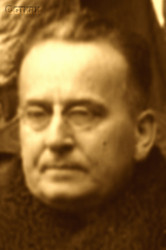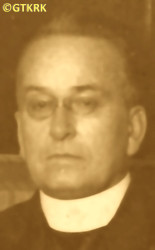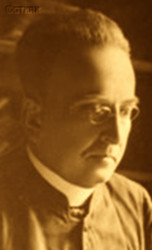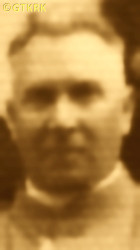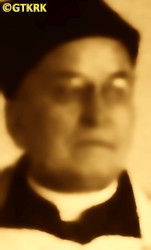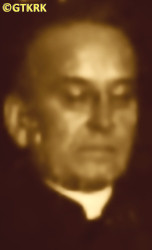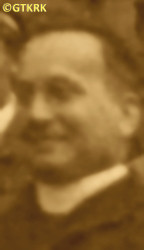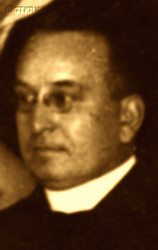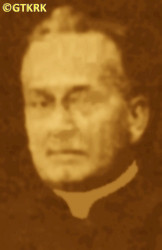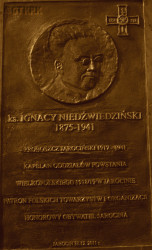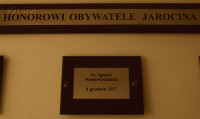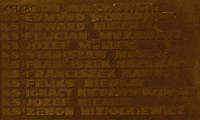Roman Catholic
St Sigismund parish
05-507 Słomczyn
85 Wiślana Str.
Konstancin deanery
Warsaw archdiocese, Poland
full list:
displayClick to display full list

searchClick to search full list by categories
wyświetlKliknij by wyświetlić pełną listę po polsku

szukajKliknij by przeszukać listę wg kategorii po polsku

Martyrology of the clergy — Poland
XX century (1914 – 1989)
personal data
surname
NIEDŹWIEDZIŃSKI
forename(s)
Ignatius (pl. Ignacy)
function
diocesan priest
creed
Latin (Roman Catholic) Church RCmore on
en.wikipedia.org
[access: 2014.09.21]
diocese / province
Gniezno and Poznań archdiocese (aeque principaliter)more on
www.archpoznan.pl
[access: 2012.11.23]
RC Military Ordinariate of Polandmore on
en.wikipedia.org
[access: 2014.12.20]
honorary titles
Minor Canonmore on
en.wikipedia.org
[access: 2014.11.14]
(St Peter and St Paul the Apostles and Nativity of the Blessed Virgin Mary RC collegiate church, Kruszwicatoday: Kruszwica gm., Inowrocław pov., Kuyavia‐Pomerania voiv., Poland
more on
en.wikipedia.org
[access: 2021.07.18])
Gold „Cross of Merit”more on
en.wikipedia.org
[access: 2019.04.16]
(03.12.1938)
date and place
of death
31.12.1941

NL Schmückertconcentration camp for nuns
today: Bojanowo, Bojanowo gm., Rawicz pov., Greater Poland voiv., Poland
more on
pl.wikipedia.org
[access: 2025.08.19]
details of death
During the Prussian rule (partitions of Poland), while studying at the Germ. Königliche Wilhelm–Gymnasium (Eng. King Wilhelm Gymnasium) in Krotoszyn — till 1899 — a member of the Polish self–educational clandestine organization Thomas Zan Society.
In 1908, after German denunciations, accused of „negligently” conducting a service on the anniversary of the birth of the German Emperor, William II, teaching religion to German children in Polish, and delivering patriotic speeches calling for efforts to restore the Polish state — as a result, transferred to another parish (Biezdrowo).
At the end of World War I, when in 07.1918 the Polish clandestine Inter‐Party Committee in Poznań was transformed into the Central Citizens' Committee, became deputy chairman of the District Citizens' Committee in Jarocin. Meetings of activists associated with the national movement were held in his rectory. Inspired in the creation of the „Unity” organization of a military nature, founded by Polish soldiers of the reserve battalion of the 46th Graf Kirchbach Infantry Regiment stationed in Jarocin and soldiers returning from the front.
At the beginning of 11.1918, the so‐called November Revolution broke out in German (it began with the sailors' mutiny in Cologne on 04.11.1918), which led to the fall of state authority and the takeover of power in many places by soldiers' and workers' councils. In Jarocin, such a Polish Workers' and Soldiers' Council was also established as early as 09‐11.11.1918. At the same time, on 09.11.1918, the German Emperor William II Hohenzollern abdicated; on 11.11.1918, the Allies and the Germans, in a staff wagon in Compiègne, in the headquarters of the French Marshal Ferdinand Foch, signed an armistice and ceasefire — which de facto meant the end of World War I; also on 11.11.1918, the Regency Council established by the Germans — operating in the territory occupied by Germany and Austria–Hungary, the so‐called Germ. Königreich Polen (Eng. Polish Kingdom) — transferred supreme command over the army to Brigadier Joseph Piłsudski and appointed him Commander‐in‐Chief of the Polish Army, which de facto meant the rebirth of the Polish state, covering however only the area of Germ. Königreich Polen, which until 1914 had been under Russian rule, and did not include the lands of the Prussian partition, which were still under German control. At that time, the Jarocin Workers' and Soldiers' Council de facto took over power in the city. German officers and soldiers were expelled from the city. The formation of a Polish military unit began and on 17.11.1918, celebrated a solemn Mass for them in the market square in Jarocin, de facto becoming their chaplain. On 12.1918, the unit numbered c. 600 soldiers.
However, this did not mean the full rule of the Polish state in Greater Poland. Although the Polish District Parliament, which convened on 03‐05.12.1918 in Poznań, and which expressed the will to create a united Polish state with access to the sea, encompassing the Polish lands of the former Prussian partition, and recognised the Supreme People's Council as the Polish legal state authority, the Germans, who still exercised military power over almost the entire area of the Prussian partition, obviously did not accept this. That is why the Greater Poland Uprising broke out on 27.12.1918. However, in Jarocin there were no German troops anymore and on 01.01.1919, a Polish banner was hung out on the town hall and during a solemn ceremony combined with a military parade, during which he delivered a „fiery” speech and accepted an oath from Polish soldiers, it was announced that the Poles had taken power in the city. Later, many of these soldiers took part in the Uprising's struggles, including in victorious skirmishes at Mrocza, Ślesin and Wysoka. The Uprising ended on 16.02.1919 with a truce in Trier, enforced by the victorious Entente states, under which the Polish insurgent Greater Poland Army was recognized as an allied army and a border was set, the crossing of which „German troops were forbidden”, leaving Greater Poland outside their influence. However, it was not until the Treaty of Versailles, concluded on 26.06.1919, that Greater Poland was formally awarded to Poland. The treaty came into force on 10.01.1920 and from that moment onwards the Polish government in Jarocin formally dates.
During the Polish–Russian War of 1919‐1921, organized help for wounded Polish and Russian soldiers in Jarocin.
After the German invasion of the Republic of Poland on 01.09.1939 (the Russians attacked Poland 17 days later) and the beginning of World War II, the Germans captured Jarocin on 06.09.1939. The German occupation began.
One of the first decisions was to turn the Christ the King church, built by him, into a furniture warehouse.
Arrested by the Germans on 05.10.1941, as part of the action to eliminate the Polish Catholic clergy in the Germ. Reichsgau Wartheland province, established in the occupied Greater Poland region.
Jailed in KL Posen (Fort VII) concentration camp.
Tortured.
Next transported to NL Schmückert concentration camp where perished in the camp's hospital.
cause of death
exhaustion
perpetrators
Germans
sites and events
NL SchmückertClick to display the description, KL PosenClick to display the description, 06.10.1941 arrests (Warthegau)Click to display the description, Reichsgau WarthelandClick to display the description, Ribbentrop‐MolotovClick to display the description, Pius XI's encyclicalsClick to display the description, Polish‐Russian war of 1919‐1921Click to display the description, Greater Poland UprisingClick to display the description, Thomas Zan SocietiesClick to display the description
date and place
of birth
30.01.1875Birth certification on:
photos.szukajwarchiwach.gov.pl
[access: 2025.08.19]

Koźmintoday: Koźmin Wielkopolski, Koźmin Wielkopolski gm., Krotoszyn pov., Greater Poland voiv., Poland
more on
en.wikipedia.org
[access: 2021.05.20]
parents
NIEDŹWIEDZIŃSKI John
🞲 ?, ? — 🕆 ?, ?

DORSZEWSKA Marianne
🞲 ?, ? — 🕆 ?, ?
presbyter (holy orders)
ordination
01.12.1902

Gnieznotoday: Gniezno urban gm., Gniezno pov., Greater Poland voiv., Poland
more on
en.wikipedia.org
[access: 2021.12.18]
Assumption of the Blessed Virgin Mary RC archcathedral churchmore on
en.wikipedia.org
[access: 2025.03.14]
positions held
1917 – 1941
parish priest — Jarocintoday: Jarocin gm., Jarocin pov., Greater Poland voiv., Poland
more on
en.wikipedia.org
[access: 2021.07.18] ⋄ St Martin the Bishop and Confessor RC parish ⋄ Jarocintoday: Jarocin gm., Jarocin pov., Greater Poland voiv., Poland
more on
en.wikipedia.org
[access: 2021.07.18] RC deanery — also: 1928‐1930 founder and builder of the Christ the King church; c. 1935‐1939 inspector of religious education in primary schools of the Jarocin district; 1920‐1939 president of the Municipal — and from 1923 District — Committee of the People's Reading Rooms Society; member of the management board of the Loan and Savings Bank
1933 – 1941
Minor Canon — Kruszwicatoday: Kruszwica gm., Inowrocław pov., Kuyavia‐Pomerania voiv., Poland
more on
en.wikipedia.org
[access: 2021.07.18] ⋄ Collegiate Chapter ⋄ St Peter and St Paul the Apostles RC collegiate church
1924 – 1932
RC auxiliary military chaplain — Jarocintoday: Jarocin gm., Jarocin pov., Greater Poland voiv., Poland
more on
en.wikipedia.org
[access: 2021.07.18] ⋄ garrison, Corps District OK No. VII Poznań, Polish Armed Forces ⋄ Ostrów Wielkopolskitoday: Ostrów Wielkopolski urban gm., Ostrów Wielkopolski pov., Greater Poland voiv., Poland
more on
en.wikipedia.org
[access: 2021.06.07], St Nicholas RC military parish ⋄ Poznańtoday: Poznań city pov., Greater Poland voiv., Poland
more on
en.wikipedia.org
[access: 2021.07.18] RC deanery — i.a. Jarocin Recruitment District Command; 1928‐1932 — Reserve Infantry Cadet Battalion No. 7A; 1924‐1926 part of the 70th Infantry Regiment
08.1922
mayor — Jarocintoday: Jarocin gm., Jarocin pov., Greater Poland voiv., Poland
more on
en.wikipedia.org
[access: 2021.07.18] — acting („ad interim”); also: since 1927 Honorary Citizen of Jarocin
1919 – 1925
membership — Jarocintoday: Jarocin gm., Jarocin pov., Greater Poland voiv., Poland
more on
en.wikipedia.org
[access: 2021.07.18] ⋄ City Council
1908 – 1917
curatus/rector/expositus — Wronkitoday: Wronki gm., Szamotuły pov., Greater Poland voiv., Poland
more on
en.wikipedia.org
[access: 2021.06.20] ⋄ RC church (in prison) ⋄ St Catherine the Virgin and Martyr RC parish ⋄ Wronkitoday: Wronki gm., Szamotuły pov., Greater Poland voiv., Poland
more on
en.wikipedia.org
[access: 2021.06.20] RC deanery — also: prison chaplain
1906 – 1908
vicar — Biezdrowotoday: Wronki gm., Szamotuły pov., Greater Poland voiv., Poland
more on
en.wikipedia.org
[access: 2021.06.20] ⋄ Exaltation of the Holy Cross and St Nicholas the Biship and Confessor RC parish ⋄ Lwówektoday: Lwówek gm., Nowy Tomyśl pov., Greater Poland voiv., Poland
more on
en.wikipedia.org
[access: 2020.11.27] RC deanery
1906
vicar — Ostrów Wielkopolskitoday: Ostrów Wielkopolski urban gm., Ostrów Wielkopolski pov., Greater Poland voiv., Poland
more on
en.wikipedia.org
[access: 2021.06.07] ⋄ St Stanislav the Bishop and Martyr RC parish ⋄ Ostrów Wielkopolskitoday: Ostrów Wielkopolski urban gm., Ostrów Wielkopolski pov., Greater Poland voiv., Poland
more on
en.wikipedia.org
[access: 2021.06.07] RC deanery
1906
administrator — Przedborówtoday: Mikstat gm., Ostrzeszów pov., Greater Poland voiv., Poland
more on
en.wikipedia.org
[access: 2021.07.18] ⋄ St Giles the Abbot RC parish ⋄ Ostrzeszówtoday: Ostrzeszów gm., Ostrzeszów pov., Greater Poland voiv., Poland
more on
en.wikipedia.org
[access: 2021.05.30] RC deanery — acting („ad interim”)
1906
administrator — Mikstattoday: Mikstat gm., Ostrzeszów pov., Greater Poland voiv., Poland
more on
en.wikipedia.org
[access: 2021.07.18] ⋄ Holy Trinity RC parish ⋄ Ostrów Wielkopolskitoday: Ostrów Wielkopolski urban gm., Ostrów Wielkopolski pov., Greater Poland voiv., Poland
more on
en.wikipedia.org
[access: 2021.06.07] RC deanery — acting („ad interim”)
1905
administrator — Opatówtoday: Łęka Opatowska gm., Kępno pov., Greater Poland voiv., Poland
more on
en.wikipedia.org
[access: 2021.07.18] ⋄ St Florian the Martyr RC parish ⋄ Kępnotoday: Kępno gm., Kępno pov., Greater Poland voiv., Poland
more on
en.wikipedia.org
[access: 2021.05.30] RC deanery — acting („ad interim”)
1902 – 1905
vicar — Opatówtoday: Łęka Opatowska gm., Kępno pov., Greater Poland voiv., Poland
more on
en.wikipedia.org
[access: 2021.07.18] ⋄ St Florian the Martyr RC parish ⋄ Kępnotoday: Kępno gm., Kępno pov., Greater Poland voiv., Poland
more on
en.wikipedia.org
[access: 2021.05.30] RC deanery
till 1902
student — Gnieznotoday: Gniezno urban gm., Gniezno pov., Greater Poland voiv., Poland
more on
en.wikipedia.org
[access: 2021.12.18] ⋄ philosophy and theology, Archbishop's Practical Theological Seminary (Lat. Seminarium Clericorum Practicum)
from 1899
student — Poznańtoday: Poznań city pov., Greater Poland voiv., Poland
more on
en.wikipedia.org
[access: 2021.07.18] ⋄ philosophy and theology, Archbishop's Theological Seminary (Collegium Leoninum)
from 1916
membership — Poznańtoday: Poznań city pov., Greater Poland voiv., Poland
more on
en.wikipedia.org
[access: 2021.07.18] ⋄ Friends of Sciences Society
author of the study „Socialism, its development and principles”, Poznań 1911; author of articles: 1907‐1910 in the biweekly Pl. „Ruch Chrześcijańsko–Społeczny” (Eng. „Christian Social Movement”), later in Pl. „Gazeta Jarocińska” (Eng. „Jarocin Newspaper”; editor of the magazine Pl. „Za Prawdę” (Eng. „For Truth”); from 1938 editor and publisher of the weekly Pl. „Gazetka Parafialna Parafii Jarocińskiej” (Eng. „Jarocin Parish Newspaper”)
membership — Poznańtoday: Poznań city pov., Greater Poland voiv., Poland
more on
en.wikipedia.org
[access: 2021.07.18] ⋄ Friends of Sciences Society
others related
in death
DERKACZEWSKAClick to display biography Stanislava (Sr Raphaella of the Holy Face), DWULECKAClick to display biography Mary (Sr Fabiola), GRYGIERClick to display biography Anne (Sr Wunibalda), GRZANKAClick to display biography Francesca (Sr Romualda), KĄKOLEWSKAClick to display biography Wanda (Sr Veronica), LEWICKAClick to display biography Claire (Sr Cordelia), ŁOPACZEWSKIClick to display biography Stanislav Kostka, MULKOWSKAClick to display biography Josefa (Sr Vestina), OSIŃSKAClick to display biography Leocadia (Sr Radegundis), SZKUDLAREKClick to display biography Helen (Sr Hermana), BŁOCIŃSKAClick to display biography Anne (Sr Iucunda), CHWOŁKAClick to display biography Hedwig (Sr Bonifacia), FIEREKClick to display biography Francesca (Sr Potamia), GRZECHOWSKAClick to display biography Mary (Sr Sapientia), KACZMAREKClick to display biography Elisabeth (Sr Rita), KŁECZEKClick to display biography (Sr Benita), ŁUCZAKClick to display biography Marianne (Sr Siriana), PIOTRZKOWSKAClick to display biography Pauline (Sr Anacleta), SIWECKAClick to display biography Regina Stephanie (Sr Angela), TUŻYNAClick to display biography Constantina (Sr Rusticula), WANIOREKClick to display biography Theodosia (Sr Flaviana), WOJCIECHOWSKAClick to display biography Theophilusa (Sr Reinharda)
sites and events
descriptions
NL Schmückert: German concentration camp Germ. Nonnenlager (Eng. camp for nuns), set up in Bojanowo (from 1943 formally known as Schmückert by the Germans, today Rawicz county), mainly for Polish nuns. Organized by the Germans in the province of Germ. Warthegau (Eng. Warta country), after the liquidation in early 1941 of c. 248 Catholic religious houses and institutions run by the Church, 30 of which were transferred directly to the German National Socialist Party NSDAP, and the rest were administered by the Germ. Gauselbstverwaltung (Eng. Self–Government of the Region–Gau) GSV state institution. Therefore, initially formally called as Germ. Gauarbeitsanstalt Schmückert (Eng. Schmückert Gau employment office). On 25.02.1941 first group of 56 nuns was brought in. At the end of 1941 there were 293 prisoners held. On 11.12.1941 Germans brought in c. 40 old and sick priests, transported from KL Posen concentration camp. Altogether in 1941‐1945 615 nuns from 27 congregations were held captive in the camp. (more on: pl.wikipedia.orgClick to attempt to display webpage
[access: 2013.08.17], www.niedziela.plClick to attempt to display webpage
[access: 2019.04.16])
KL Posen: German Posen — Fort VII — camp founded in c. 10.10.1939 in Poznań till mid of 11.1939 operated formally as Germ. Konzentrationslager (Eng. concentration camp) KL Posen, and this term is used throughout the White Book, also later periods. It was first such a concentration camp set up by the Germans on Polish territory — in case of Greater Poland (Wielkopolska) directly incorporated into German Reich. In 10.1939 in KL Posen for the first time Germans used gas to murder civilian population, in particular patients of local psychiatric hospitals. From 11.1939 the camp operated as German political police Gestapo prison and transit camp (Germ. Übergangslager), prior to sending off to concentration camps, such as KL Dachau or KL Auschwitz. In 28.05.1941 the camp was rebranded as police jail and slave labour corrective camp (Germ. Arbeitserziehungslager). At its peak up to 7‐9 executions were carried in the camp per day, there were mass hangings of the prisoners and some of them were led out to be murdered elsewhere, outside of the camp. Altogether in KL Posen Germans exterminated approx. 20,000 inhabitants of Greater Poland (Wielkopolska) region, including many representatives of Polish intelligentsia, patients and staff of psychiatric hospitals and dozen or so Polish priests. Hundreds of priests were held there temporarily prior to transport to other concentration camps, mainly KL Dachau. From 03.1943 the camp had been transformed into an industrial complex (from 25.04.1944 — Telefunken factory manufacturing radios for submarines and aircrafts). (more on: www.wmn.poznan.plClick to attempt to display webpage
[access: 2019.02.02], en.wikipedia.orgClick to attempt to display webpage
[access: 2013.12.27])
06.10.1941 arrests (Warthegau): On 13.09.1941 Germ. Gauleiter (Eng. regional leader) of German province Germ. Reichsgau Wartheland (Eng. Wartheland Reich district), in German‐occupied Greater Poland (where German standard law was in force), Artur Greiser, implementing „Ohne Gott, ohne Religion, ohne Priesters und Sakramenten” — „without God, without religion, without priest and sacrament” — policy issued a decree formally dissolving Catholic Church and forming in its place a Roman Catholic German National Church in Germ. Warthegau, an organization subject to a German private law. The ordinance was issued backdated to 01.09.1939, i.e. the date of the German invasion of Poland, which sanctioned the later robbery of the property of the Catholic Church acting for the benefit of the Polish population by the Germans. All the contacts with Vatican were forbidden. All the religion congregations were also dissolved. Soon after, on 06‐07.10.1941, mass arrests of Polish Catholic priests took place — c. 352 were detained. All were herded into DL Konstantinow in Konstantynów or IL Lond in Ląd on Warta river transit camps or KL Posen concentration camp (in this case, the detainees were first registered, photographed and examined in the infamous Poznań headquarters of the German political police, the Gestapo, in the former Soldier's House). On 30.10.1941 most of them were transported to KL Dachau concentration camp.
Reichsgau Wartheland: After the Polish defeat in the 09.1939 campaign, which was the result of the Ribbentrop‐Molotov Pact and constituted the first stage of World War II, and the beginning of German occupation in part of Poland (in the other, eastern part of Poland, the Russian occupation began), the Germans divided the occupied Polish territory into five main regions (and a few smaller). The largest one was transformed into Germ. Generalgouvernement (Eng. General Governorate), intended exclusively for Poles and Jews and constituting part of the so‐called Germ. Großdeutschland (Eng. Greater Germany). Two were added to existing German provinces. From two other separate new provinces were created. Greater Poland region was one of them, incorporated into Germany on 08.10.1939, by decree of the German leader Adolf Hitler (formally came into force on 26.10.1939), and on 24.01.1940 transformed into the Germ. Reichsgau Wartheland (Eng. Wartheland Reich Province), in which the law of the German state was to apply. The main axis of the policy of the new province, the territory of which the Germans recognized as the Germ. „Ursprünglich Deutsche” (Eng. „natively German”), despite the fact that 90% of its inhabitants were Poles, was Germ. „Entpolonisierung” (Eng. „Depolonisation”), i.e. forced Germanization. C. 100,000 Poles were murdered as part of the Germ. „Intelligenzaktion”, i.e. extermination of Polish intelligentsia and ruling classes. C. 630,000 were forcibly resettled to the Germ. Generalgouvernement, and their place taken by the Germans brought from other areas occupied by Germany (e.g. the Baltic countries, Bessarabia, Bukovina, etc.). Poles were forced to sign the German nationality list, the Germ. Deutsche Volksliste DVL. As part of the policy of „Ohne Gott, ohne Religion, ohne Priesters und Sakramenten” (Eng. „No God, no religion, no priest or sacrament”) most Catholic priests were arrested and sent to concentration camps. All schools teaching in Polish, Polish libraries, theaters and museums were closed. Polish landed estates confiscated. To further reduce the number of the Polish population, Poles were sent to forced labor deep inside Germany, and the legal age of marriage for Poles was increased (25 for women, 28 for men). The German state office, Germ. Rasse‐ und Siedlungshauptamt (Eng. Main Office of Race and Settlement) RuSHA, under the majesty of German law, abducted several thousand children who met specific racial criteria from Polish families and subjected them to forced Germanization, handing them over to German families. After the end of hostilities of World War II, the overseer of this province, the Germ. Reichsstatthalter (Eng. Reich Governor) and the Germ. Gauleiter (Eng. district head) of the German National Socialist Party, Arthur Karl Greiser, was executed. (more on: en.wikipedia.orgClick to attempt to display webpage
[access: 2024.06.21])
Ribbentrop‐Molotov: Genocidal Russian‐German alliance pact between Russian leader Joseph Stalin and German leader Adolf Hitler signed on 23.08.1939 in Moscow by respective foreign ministers, Mr. Vyacheslav Molotov for Russia and Joachim von Ribbentrop for Germany. The pact sanctioned and was the direct cause of joint Russian and German invasion of Poland and the outbreak of the World War II in 09.1939. In a political sense, the pact was an attempt to restore the status quo ante before 1914, with one exception, namely the „commercial” exchange of the so‐called „Kingdom of Poland”, which in 1914 was part of the Russian Empire, fore Eastern Galicia (today's western Ukraine), in 1914 belonging to the Austro‐Hungarian Empire. Galicia, including Lviv, was to be taken over by the Russians, the „Kingdom of Poland” — under the name of the General Governorate — Germany. The resultant „war was one of the greatest calamities and dramas of humanity in history, for two atheistic and anti‐Christian ideologies — national and international socialism — rejected God and His fifth Decalogue commandment: Thou shall not kill!” (Abp Stanislav Gądecki, 01.09.2019). The decisions taken — backed up by the betrayal of the formal allies of Poland, France and Germany, which on 12.09.1939, at a joint conference in Abbeville, decided not to provide aid to attacked Poland and not to take military action against Germany (a clear breach of treaty obligations with Poland) — were on 28.09.1939 slightly altered and made more precise when a treaty on „German‐Russian boundaries and friendship” was agreed by the same murderous signatories. One of its findings was establishment of spheres of influence in Central and Eastern Europe and in consequence IV partition of Poland. In one of its secret annexes agreed, that: „the Signatories will not tolerate on its respective territories any Polish propaganda that affects the territory of the other Side. On their respective territories they will suppress all such propaganda and inform each other of the measures taken to accomplish it”. The agreements resulted in a series of meeting between two genocidal organization representing both sides — German Gestapo and Russian NKVD when coordination of efforts to exterminate Polish intelligentsia and Polish leading classes (in Germany called «Intelligenzaktion», in Russia took the form of Katyń massacres) where discussed. Resulted in deaths of hundreds of thousands of Polish intelligentsia, including thousands of priests presented here, and tens of millions of ordinary people,. The results of this Russian‐German pact lasted till 1989 and are still in evidence even today. (more on: en.wikipedia.orgClick to attempt to display webpage
[access: 2015.09.30])
Pius XI's encyclicals: Facing the creation of two totalitarian systems in Europe, which seemed to compete with each other, though there were more similarities than contradictions between them, Pope Pius XI issued in 03.1937 (within 5 days) two encyclicals. In the „Mit brennender Sorge” (Eng. „With Burning Concern”) published on 14.03.1938, condemned the national socialism prevailing in Germany. The Pope wrote: „Whoever, following the old Germanic‐pre‐Christian beliefs, puts various impersonal fate in the place of a personal God, denies the wisdom of God and Providence […], whoever exalts earthly values: race or nation, or state, or state system, representatives of state power or other fundamental values of human society, […] and makes them the highest standard of all values, including religious ones, and idolizes them, this one […] is far from true faith in God and from a worldview corresponding to such faith”. On 19.03.1937, published „Divini Redemptoris” (Eng. „Divine Redeemer”), in which criticized Russian communism, dialectical materialism and the class struggle theory. The Pope wrote: „Communism deprives man of freedom, and therefore the spiritual basis of all life norms. It deprives the human person of all his dignity and any moral support with which he could resist the onslaught of blind passions […] This is the new gospel that Bolshevik and godless communism preaches as a message of salvation and redemption of humanity”… Pius XI demanded that the established human law be subjected to the natural law of God , recommended the implementation of the ideal of a Christian state and society, and called on Catholics to resist. Two years later, National Socialist Germany and Communist Russia came together and started World War II. (more on: www.vatican.vaClick to attempt to display webpage
[access: 2023.05.28], www.vatican.vaClick to attempt to display webpage
[access: 2023.05.28])
Polish‐Russian war of 1919‐1921: War for independence of Poland and its borders. Poland regained independence in 1918 but had to fight for its borders with former imperial powers, in particular Russia. Russia planned to incite Bolshevik‐like revolutions in the Western Europe and thus invaded Poland. Russian invaders were defeated in 08.1920 in a battle called Warsaw battle („Vistula river miracle”, one of the 10 most important battles in history, according to some historians). Thanks to this victory Poland recaptured part of the lands lost during partitions of Poland in XVIII century, and Europe was saved from the genocidal Communism. (more on: en.wikipedia.orgClick to attempt to display webpage
[access: 2014.12.20])
Greater Poland Uprising: Military insurrection of Poles of former German Germ. Posen Provinz (Eng. Poznań province) launched against German Reich in 1918‐1919 — after the abdication on 09.11.1918 of the German Emperor William II Hohenzollern; after the armistice between the Allies and Germany signed on 11.1.1918 in the HQ wagon in Compiègne, the headquarters of Marshal of France Ferdinand Foch — which de facto meant the end of World War I — against the German Weimar Republic, established on the ruins of the German Empire, aiming to incorporate lands captured by Prussia during partitions of Poland in XVIII century into Poland. The Republic of Poland, reborn on 11.11.1918, initially formally included only the so‐called Germ. Königreich Polen (Eng. Kingdom of Poland), i.e. the territory that had been under Russian rule until 1915 and then under the control of Central States (Germany and Austria–Hungary), but did not include the Prussian partition. Started on 27.12.1918 in Poznań and ended on 16.02.1919 with the armistice pact in Trier, forced by the victorious Entente states, which included provisions ordering Germany to cease operations against Poland and, importantly, recognizing the Polish insurgent Greater Poland Army as an allied armed force of the Entente. De facto it turned out to be a Polish victory, confirmed in the main peace treaty after World War I, the Treaty of Versailles of 28.06.1919, which came into force on 10.01.1920 and in which most of the lands of the Prussian partition were recognized as Polish. Many Polish priests took part in the Uprising, both as chaplains of the insurgents units and members and leaders of the Polish agencies and councils set up in the areas covered by the Uprising. In 1939 after German invasion of Poland and start of the World War II those priests were particularly persecuted by the Germans and majority of them were murdered. (more on: en.wikipedia.orgClick to attempt to display webpage
[access: 2016.08.14])
Thomas Zan Societies: Secret societies of Polish youth, aiming at self‐education, patriotic in form and content, functioning 1830‐1920, in mutiny against enforced Germanisation and censure of Polish culture, mainly in secondary schools — gymnasia — mainly in Greater Poland (Wielkopolska) and later in Silesia. The first groups were formed in 1817. In 1897 a congress in Bydgoszcz was held when rules of clandestine activities were formulated. At other congress in Bydgoszcz in Poznań a „Red Rose” society was formed, heading all others groups in various gymnasiums and coordinating their activities. In 1900 „Red Rose” consolidated Philomaths organizations from Pomerania as well. After Toruń trial of Pomeranian Philomaths in Toruń Germans arrested 24 members of Thomas Zan Society from Gniezno. 21 of them were sentenced up to 6 weeks in prison and reprimands. All were relegated from schools without the right to continue education in secondary and higher schools in Prussia. Despite repression the Societies existed till 1918 and rebirth of Poland. (more on: pl.wikipedia.orgClick to attempt to display webpage
[access: 2021.12.19])
sources
personal:
www.wtg-gniazdo.orgClick to attempt to display webpage
[access: 2012.11.23], jarocin.plClick to attempt to display webpage
[access: 2015.09.30], www.youtube.comClick to attempt to display webpage
[access: 2021.12.19], photos.szukajwarchiwach.gov.plClick to attempt to display webpage
[access: 2025.08.19], www.opiekun.kalisz.plClick to attempt to display webpage
[access: 2015.09.30]
bibliographical:
„Social Activist Priests in Greater Poland”, collective work, Biographical Dictionary, vol. 2 I‐O, 2007
original images:
www.youtube.comClick to attempt to display webpage
[access: 2021.12.19], www.limis.ltClick to attempt to display webpage
[access: 2024.06.09], historiajarocina.plClick to attempt to display webpage
[access: 2024.12.13], jarocin.plClick to attempt to display webpage
[access: 2015.09.30], historiajarocina.plClick to attempt to display webpage
[access: 2024.12.13], historiajarocina.plClick to attempt to display webpage
[access: 2024.12.13], historiajarocina.plClick to attempt to display webpage
[access: 2024.12.13], historiajarocina.plClick to attempt to display webpage
[access: 2024.12.13], www.youtube.comClick to attempt to display webpage
[access: 2021.12.19], www.wbc.poznan.plClick to attempt to display webpage
[access: 2021.05.06], www.wtg-gniazdo.orgClick to attempt to display webpage
[access: 2012.11.23], www.wtg-gniazdo.orgClick to attempt to display webpage
[access: 2012.11.23], www.wtg-gniazdo.orgClick to attempt to display webpage
[access: 2012.11.23]
LETTER to CUSTODIAN/ADMINISTRATOR
If you have an Email client on your communicator/computer — such as Mozilla Thunderbird, Windows Mail or Microsoft Outlook, described at WikipediaPatrz:
en.wikipedia.org, among others — try the link below, please:
LETTER to CUSTODIAN/ADMINISTRATORClick and try to call your own Email client
If however you do not run such a client or the above link is not active please send an email to the Custodian/Administrator using your account — in your customary email/correspondence engine — at the following address:

giving the following as the subject:
MARTYROLOGY: NIEDŹWIEDZIŃSKI Ignatius
To return to the biography press below:
 Click to return to biography
Click to return to biography








